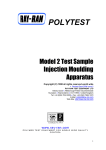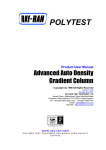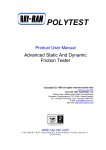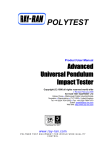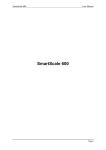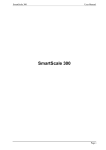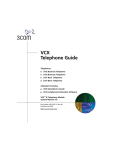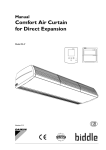Download Manual - Ray-Ran Test Equipment LTD
Transcript
POLYTEST Product User Manual 5 Series Advanced Melt Flow Systems Copyright (C) 1998 All Rights Reserved Revised Feb 2003 issue1 RAY-RAN TEST EQUIPMENT LTD Kelsey Close • Attleborough Fields Industrial Estate Nuneaton • Warwickshire • CV11 6RS • United Kingdom Tel : +44 (0)24 7634 2002 • Fax : +44 (0)24 7664 1670 E-Mail : [email protected] Web Site : http://www.ray-ran.com www.ray-ran.com POLYMER TEST EQUIPMENT FOR WORLD WIDE QUALITY CONTROL 5 Series Advanced Melt Flow Systems CONTENTS User Manual..................................................................................... 3 Introduction ..................................................................................... 3 Model 5MBA......................................................................................3 Model 5SA.........................................................................................3 Model 5MPCA ...................................................................................4 Electrical Power Supply ................................................................. 4 Shipping Specifications ................................................................. 4 Product Specification Chart........................................................... 4 Lifting & Installation........................................................................ 5 Preventative Maintenance .............................................................. 5 Caution during The Operation Of The Machine............................ 5 Polymer Test Samples.................................................................... 6 Procedural Conditions.................................................................... 6 Test Weights.................................................................................... 6 Preheat Time & Charging the Polymer Into The Cylinder ........... 7 Cleaning the Apparatus.................................................................. 8 Polymer Density at Test Temperature Determination ................. 8 Operating Procedure ...................................................................... 8 Model 5MBA......................................................................................8 Model 5SA.........................................................................................9 Model 5MPCA ...................................................................................9 Melt Densities ................................................................................ 12 Ray-Ran Products & Services...................................................... 13 2 5 Series Advanced Melt Flow Systems User Manual Please read this manual before operating the apparatus. The information contained in this manual will explain how to use the apparatus and also assist the operator to obtain accurate test results. However, if you have any questions regarding the use of the apparatus, then please contact the sales department at Ray-Ran on +44 (0)24 76342002 for assistance. Introduction The principal employed is to determine the mass flow rate of a molten polymer passing through a closely controlled orifice (die) under set conditions of constant temperature and constant pressure produced by a dead weight system. These test parameters are referred to as the procedural conditions. The mass flow rate of the polymer is measured in grams per 10 minutes, and this value is known as the melt flow index or MFI for the polymer. Although the MFI value is not a fundamental property of the polymer, it does however, give an indication of the flow characteristics of the polymer and it has become one of the most widely used references for the quality control of polymers. The test methods and the basic design concept of the apparatus employed to determine the MFI values are universally accepted and the various International Standards are based upon this agreed method of testing. In simple terms, the polymer is loaded into a cylinder bore already heated to the required temperature. A weighted piston is placed into the top of the cylinder bore and after an initial period of time to allow the polymer to become molten (known as the preheat cycle), the amount of polymer (the extrudate) passing through the die is measured. This can be done in two ways. Over a set time interval and then by weighting the extrudate so that a mass flow rate over 10 minutes can be readily calculated to give the MFI. Or, by recording the time it takes the piston to descend over a set travel distance, which gives the volumetric flow rate, and by multiplying the result of the density of the polymer at test temperature and converting this to a 10 minute period, the MFI is obtained. These different test procedures will be explained in detail later on. The series 5 models have been designed to measure the melt flow index of polymers in accordance with the test procedures laid down in the International Standards. Three different models are available. They are all based on a common cabinet layout and a modular design concept which enables the apparatus, if required, to be upgraded. The model designations and outline specifications are shown as follows. For the detailed specification of each model see the section “Product Specification Chart”. Model 5MBA This is the basic model which is manually operated. The test procedure is very simple to undertake. The polymer extrudate that passed through the die during a selected time interval, is collected by taking a manual cut-off of the polymer. The cut-off sample is then weighed and using the time interval, the equivalent polymer flow rate over 10 minutes can easily be determined, thus giving the melt flow index. Model 5SA This model is a semi-automatically operated and controlled apparatus using the Ray-Ran level 1 microprocessor. The liquid crystal display (LCD) provides a menu driven prompt sequence for data entry via the keypad and a simple logic display to select the choice of program between the determination of the polymer density at test temperature and an MFI test. The polymer flow rate passing through the die is automatically measured and the MFI result shown on the LCD. 3 5 Series Advanced Melt Flow Systems Model 5MPCA A fully automated melt flow indexer using the Ray-Ran level 2 microprocessor. The liquid crystal display (LCD) provides a complete menu driven prompt sequence for data input via the keypad and a simple yes / no logic display to select the choice of program. This includes the determination of the polymer density at test temperature, a multi-slicing test and a single melt flow index test. A simple “purge” and “load hold” facility are also provided using the optional weight loader. The test results are automatically displayed on the LCD and a hard copy provided on the built-in printer. An RS232 output connection is provided to link to a computer using the Ray-Ran “Data View” Windows software to provide additional data capture, statistics and histograms. Electrical Power Supply The machine can be supplied in two versions as follows. 220 volts @ 50 Hz 110 volts @ 60 Hz Please check the machine label to confirm the voltage required. The machine power supply inlet socket is fitted with a 10 amp fuse. The main power supply plug must be earthed and fitted with a 13 amp fuse. Shipping Specifications Specification Net Weight (kg) Gross Weight (kg) Width (cm) Length (cm) Height (cm) Model 5MBA Model 5SA Model 5MPCA 33 45 57 58 90 36 48 57 58 90 48 60 57 58 90 Please note that the above weights will increase if heavy test weights are included. For a complete set of test weights add approximately 30 kg to the weight. Product Specification Chart Feature Fully microprocessor controlled test procedure Semi-automatic controlled test procedure Manually operated test procedure RS232 serial output for computer link Ray-Ran Data View Windows software Built-in printer for hard copy test results Key pad for data entry Digital temperature control Variable distance piston travel (0.01 mm resolution) Density determination at test temperature Multi-slicing feature with histogram Windows software Viscosity measurement Shear rate measurement Shear stress measurement 5MPCA • • • • • • • • • • • • • 5SA 5MBA • • • • • • • • 4 5 Series Advanced Melt Flow Systems Feature Statistical analysis averages standard deviation Standard test die Piston assembly Replaceable cylinder liner Cylinder level indicator Weight loader with hold back and purge facility (optional) Full complement of tools for loading and cleaning 2.160 kg test weight Graduated polymer loading shuttle Traceable certificates of calibration 5MPCA • • • • • 5SA 5MBA • • • • • • • • • • • • • • • • • • • • Lifting & Installation The apparatus can easily be lifted by two people by holding one hand under the front of the base of the unit and the other hand on the side of the upright cabinet. The apparatus must be fitted with the adjustable feet supplied, mounted at each corner of the base of the unit. To set the unit in its correct working position insert the levelling device into the cylinder bore and adjust the levelling feet to position the bubble concentric with the reference lines. Note, if the apparatus is being readjusted, the cylinder MUST be cooled to room temperature first, otherwise the level indicator will be damaged. Preventative Maintenance If properly looked after Ray-Ran Melt Flow Indexers will provide many years of trouble free operation. We experience very few problems with our equipment, but when we do, most of them are as a direct result of neglect. NEVER drop the test die into the bottom of the cylinder. Always use the die tool to lower the die into position. The cylinder bore, piston and die should be cleaned after each test. If polymer deposits are allowed to build up on these components, not only will the test results be affected, but the components, especially the cylinder bore and piston will become damaged. When the brass guide is fitted as a guide for the piston it MUST always be free to slide up and down the outside of the piston. At regular intervals inspect the apparatus for damage or wear. Often, operators do not appreciate that a soft molten polymer can be abrasive and wear a hard metal face. If you get unexpected test results test another polymer that you are confident of the test result. If this checks out OK then the results of the first polymer are probably correct. However, if it is clear that the apparatus is at fault please contact Ray-Ran for advice. We strongly recommend that the apparatus should be calibrated at least once a year. Ray-Ran offer a 24 hour calibration service supported by our certificates of conformity. Please call +44 (0)1203 342002, and our sales personnel will make all the arrangements. Caution during The Operation Of The Machine The cylinder barrel can be heated up to 400 °C. 5 5 Series Advanced Melt Flow Systems Although the area around the cylinder has been insulated / lagged, this region of the apparatus will become hot and especially the top plate of the cylinder where the polymer is loaded. Therefore, care should be taken and direct contact with the cylinder avoided. It has become a common practice to clean the cylinder, piston and die whilst the components are still hot. Therefore, we strongly recommend that protective gloves are worn. Polymer Test Samples The polymer sample can be in any form that can readily be introduced into the cylinder bore. For example, powders, granules, strips of film or moulded slugs. Most materials do not require conditioning prior to testing. However, materials which contain volatile components or are chemically reactive will probably require conditioning. The moisture content of polymers can effect the flow characteristics and in some instances accelerate the degradation at high temperatures. If conditioning is necessary refer to the material specification and ASTM D618 methods for conditioning plastics and electrical insulating materials. Procedural Conditions The following test conditions have been found satisfactory for the materials listed. Material Acetals (Copolymer & Homopolymer) Acrylics Acrylonitrile-Butadiene-Styrene Cellulose Esters Nylon Polychlorotrifuorethylene Polyethylene Polycarbonate Polypropylene Polystyrene Polyterphalate Pol (Vinyl Acetal) Pol (Phenylene Sulfide) Condition 190 °C / 2.160 kg 190 °C / 1.050 kg 230 °C / 1.200 kg 230 °C / 3.800 kg 200 °C / 5.000 kg 230 °C / 3.800 kg 190 °C / 0.325 kg 190 °C / 2.160 kg 190 ° / 21.600 kg 210 °C / 2.160 kg 275 °C / 0.325 kg 235 °C / 1.000 kg 235 °C / 2.160 kg 235 °C / 5.000 kg 265 °C / 12.500 kg 125 °C / 0.325 kg 125 °C / 2.160 kg 190 °C / 0.325 kg 190 °C / 2.160 kg 310 °C / 12.500 kg 300 °C / 1.200 kg 230 °C / 2.160 kg 200 °C / 5.000 kg 320 °C / 1.200 kg 190 °C / 5.000 kg 250 °C / 2.160 kg 210 °C / 2.160 kg 285 °C / 2.160 kg 150 °C / 2.160 kg 315 °C / 5.000 kg Test Weights The piston used with the 5 Series Advanced Melt Flow Systems is fitted with a disc which moves the travel distance measuring arm down as the piston descends. The weight of the piston and the disc is 0.325 kg which is the smallest weight used for MFI tests and any additional weights used with the piston takes account of this weight. Test weights are available to meet with the requirements laid down in all International Test Standards. The test weights carried in stock are listed as follows. 6 5 Series Advanced Melt Flow Systems Load 1.000 kg 1.050 kg 1.200 kg 2.160 kg 3.800 kg 5.000 kg 10.000 kg (2 pcs) 12.500 kg (2 pcs) 21.600 kg (3 pcs) Actual Weight 0.675 kg + piston 0.725 kg + piston 0.875 kg + piston 1.835 kg + piston 3.475 kg + piston 4.675 kg + piston 4.675 kg + 5.000 kg + piston 4.675 kg + 7.500 kg + piston 4.675 kg + 7.500 kg + 9.100 kg + piston Part Number 2800-06-02 2800-06-03 2800-06-04 2800-06-05 2800-06-06 2800-06-07 2800-06-08 2800-06-09 2800-06-10 The 5.000 kg (4.675 kg) is common to the 10.000 kg, 12.500 kg & 21.600 kg. The 7.500 kg is common to the 12.000 kg & 21.600 kg. The test weights can be purchased individually as per their part number above or as a complete set giving a large cost saving on the common weights. 21.600 kg 12.500 kg 10.000 kg 9.100 kg 7.500 kg 5.000 kg 7.500 kg 5.000 kg 5.000 kg C B A 5.000 kg Preheat Time & Charging the Polymer Into The Cylinder To ensure repeatability of test results, all International Standards specify that the piston travel distance selected, over which the extrusion time is to be measured, shall start at a set distance immediately above the top of the die to the bottom face of the piston. To observe the correct positioning of the piston reference marks are scribed on the piston such that when they coincide with the top of the cylinder the position of the bottom of the piston relative to the top of the die is at the specified start position. Before commencing MFI tests the cylinder with the piston and die in place must be allowed to stand for 15 minutes at test temperature. This is not necessary for any subsequent tests immediately carried out providing when the piston is removed it is placed on an insulated surface. The nominal preheat time allowed for the polymer to plasticise before measurements are taken is 6 minutes for British or ISO Standards and 7 minutes for ASTM Standards. However, There may be instances where longer preheat times are shown to be necessary. In these cases it must be confirmed that the additional resident time of the polymer does not affect the structure or flow characteristics of the material and the test reports must highlight the change in test parameters. 7 5 Series Advanced Melt Flow Systems It is important that the correct amount of polymer to be loaded into the cylinder is determined. If too much polymer is loaded, when the preheat cycle is completed, the position of the piston will be above the designated start position. Conversely, if too little polymer is loaded, the piston will be below the start position. Sometimes it is difficult with some polymers to gauge the correct amount of polymer to be loaded into the cylinder. In these instances, it is acceptable to try and adjust the position of the piston, providing that any adjustments are made WITHIN the first 4 minutes of the preheat cycle. If the rate of descent of the piston is too slow an addition weight or hand pressure can be applied to accelerate the piston travel. This is referred to as “purging”. If the piston is moving too quickly the weights acting on the piston can be held back “arrested” for a period of time. When loading the polymer into the cylinder it is important to ensure that the test sample is packed tightly and given an initial purge by hand to exclude any entrapped air in order to eliminate bubbles in the extrudate. Cleaning the Apparatus Immediately after completing the tests discharge the remaining polymer through the die and push the die out through the top of the cylinder with the tools provided. The cylinder can be cleaned out with cloth patches lightly soaked with a suitable solvent and placed over the end of the cleaning rod provided with the set of tools. Clean the die & piston thoroughly before reuse. Unless the apparatus is properly cleaned it WILL effect the accuracy of the test results. Polymer Density at Test Temperature Determination The polymer density at test temperature can be determined on any of the series 5 Melt Flow Indexers. In the case of the model 5MPCA a set routine is provided in the menu choice. The method is straight forward. Collect a polymer extrudate over a known piston travel and then weigh it. The density is obtained by dividing the weight of the extrudate by the volume of the extrudate which is calculated as follows. The mean area of the piston and cylinder = 0.710669 cm2. Let piston travel distance measured = X cm. Let weight of extrudate = Y grams. Density at test temperature = Y / 0.710669 X grams per cm3. Operating Procedure It is most important that the previous sections of this manual have been read and properly understood before operating the apparatus. With all models ensure that the apparatus is clean and the components are heated to the required temperature as previously mentioned. The choice of the test temperature and test weights referred to in the operating procedures will be assumed to be in accordance to those previously mentioned see Procedural Conditions. Model 5MBA The control / display panel consists of a temperature controller showing the actual temperature in the cylinder barrel and a stopwatch. Temperature Controller bottom line shows the temperature SET POINT, which is the temperature selected by the operator at which the test is to be carried out. The SET POINT is adjusted by pressing the UP and DOWN buttons. The top Line shows the actual temperature of the barrel. 8 5 Series Advanced Melt Flow Systems The stopwatch shows the time in seconds to measure first the preheat time and then the extrusion time taken to obtain the MFI result. The STOP / START buttons are used to measure the respective time intervals and the RESET button resets the timer to zero. Select the temperature and load according to the polymer specification as shown in the table such that the MFI flow rates will fall between 0.15 and 50 g/10 minutes. Adjust the temperature SET POINT to the selected value and with the die and piston in position allow the actual temperature to stabilise at the SET POINT temperature for 15 minutes. Remove the piston and place on an insulated surface. Important - The 15 minute delay is only necessary for the first test. Charge the cylinder with the polymer test sample as follows. Flow Rate (g/10 minutes) 0.15 to 1.00 1.00 to 3.50 3.50 to 10.00 10.00 to 25.00 25.00 to 50.00 Suggested Weight Of Sample In Cylinder (g) 2.5 to 3.0 3.0 to 5.0 5.0 to 8.0 4.0 to 8.0 4.0 to 8.0 Time Interval (minutes) 6.00 3.00 1.00 0.50 0.25 Factor For Obtaining Flow Rate (g/10 minutes) 1.67 3.33 10.00 20.00 40.00 Place the weighted piston in position and start the preheat countdown starting from 6 or 7 minutes according to the Standard being used. Purge or arrest the weights as necessary during the first 4 minutes of the preheat cycle to ensure that the bottom scribe line on the piston will coincide with the top of the cylinder at the end of the preheat cycle. If it becomes clear that the piston will not be positioned correctly the test must be aborted and repeated with the polymer load adjusted accordingly. It can be helpful to take interim cut-offs of the extrudate during the test to check for bubbles which may be masked due to their size or the opacity of the polymer. When the bottom scribe mark on the piston coincides with the top of the cylinder, simultaneously reset the timer to zero and make a cut-off of the extrudate. Collect the next extrudate at exactly the time interval given in the table. Weigh the extrudate and multiply the weight by the factor shown in the table to obtain the Melt Flow Index in grams/10 minutes. Model 5SA The control / display panel consists of an LCD showing the actual temperature in the cylinder barrel and an LCD which automatically prompts the operator for data entry and menu choice. Also after the test has been performed it automatically displays the results. There is also a keypad for data entry. The 5SA model is fitted with the level 1 microprocessor control which is identical to the level 2 microprocessor fitted to the 5MPCA except it does NOT have a hard copy printer, RS232 computer link or a MFI multi-slicing feature. However, the test procedures are almost identical, and therefore, please refer to the 5MPCA procedure. Model 5MPCA The control / display panel is the same as the 5SA above but in addition it has a hard copy printer and at the rear of the apparatus an RS232 output for a computer linkup. 9 5 Series Advanced Melt Flow Systems The 5MPCA model is fitted with the level 2 microprocessor control which is similar to the level 1 microprocessor but with additional features, notably, a built-in printer that automatically provides hard copy printouts of the test results, an RS232 output to download the test results using the Ray-Ran “Data View” computer program to a PC and a test procedure to provide a multi-slicing feature where 20 individual MFI tests are performed in a single continuous test. Multi-slicing is selectable over 5 mm or 35 mm to accommodate both low and high flow rates. When the unit is turned on the time & date is displayed using the internal clock of the apparatus. If need be, by selecting ALTER, the time & date can be changed. The display then prompts ZERO ENCODER. Important Note - The piston travel distance is measured by a very accurate encoder. In order for the encoder to reference itself each time the apparatus is switch on the measuring arm which descends with the piston must be moved up and down by hand to allow the encoder to pass through its reference point. By doing so, the encoder can automatically set the starting position of the measuring arm from which the piston travel distance is measured. The display then prompts OPERATOR IDENTIFICATION - select and enter. The display then prompt - MATERIAL REFERENCE - select and enter. The display then prompts - BATCH REFERENCE - select and enter. The display then shows the last test temperature used - accept as OK or alter. The display then shows the last test weight used - accept as OK or alter. The display then shows the last preheat time used - accept as OK or alter. The display now allows the operator to page between an MFI test or density test and select which test is required. By now the program logic should be familiar and if a density test is selected a similar routine of data entry will allow the operator to easily follow the test sequence. If an MFI test is selected the density of the polymer at test temperature is requested. If the density test has not been carried out it is assumed this value is known. The operator is then given a choice paging from standard single MFI test and a multi-slicing test. A multi-slicing test performs 20 MFI tests in one continuous test. This option is not available on the 5SA model. If a multi-slicing test is requested the operator is given two piston travel distances over which the test can be performed, either 35 mm or 5 mm, the latter intended for very low viscosity polymers. Select the appropriate travel distance. The display then prompts CLEAN BARREL - if already done, continue. If the temperature is not at test temperature the display will ask you to wait until it is within 1 degree of the set point. As soon as the temperature is correct, the display will prompt to load the polymer and weights and when this has been done, Press YES. Immediately, the display will show the preheat countdown time and the piston position. 10 5 Series Advanced Melt Flow Systems If after the preheat countdown time has elapsed the piston is not in the correct position to start the MFI test the display will advise if it is too high or too low and if you want to stop the test and try again with a different amount of polymer. In this case, the display reverts back to CLEAN BARREL. The Piston must be in range or the test will abort. Assuming a correct preheat cycle, the display resets and starts counting the extrusion time and piston descent until the piston travel distance selected is reached. The average MFI result is then displayed. If you now press YES to save the results the printer automatically prints out the MFI readings for each of the 20 slices. If a computer is linked to the apparatus, by selecting DOWNLOAD RESULTS the information is sent to the computer, and using the Ray-Ran “Data View” Windows program supplied, the results displayed as individual results or as a histogram. Once more than 3 tests have been carried out statistical information is also available. You are now asked if you wish to do another test. By answering YES, the program reverts to CLEAN BARREL and the steps as previously described repeated. If you answer is NO you will be asked if this is the end of this batch. If it is not, press NO, and you will revert back to ANOTHER TEST. If it is the end of the batch, press YES and you will be asked PRINT STATISTICS. By answering YES, the printer produces the statistical information. Generally, this choice is made after several tests have been done so that meaningful statistical information can be produced. By answering NO takes you back to the start of the program. If a single MFI Test is requested the display prompts for the measuring distance (piston travel). The measuring distance can be between 0.1 to 35 mm. Normally, the choice would reflect the viscosity of the polymer to be tested such that the time required to undertake a test would not be unnecessarily long. The remaining procedure is basically the same as for multi-slicing. Before doing any physical tests we suggest you switch the apparatus on and enter some typical information and values as requested on the LCD . When you reach the stage where the screen says LOAD POLYMER AND WEIGHTS - PRESS YES, just press YES and the preheat cycle will start and immediately, the display will show the preheat countdown time and the position of the piston. By hand, move the measuring arm down until the display reads IN RANGE. Hold the measuring arm in this position until the preheat cycle counts down to zero. At this point, the actual MFI test will start and the display will show the test time and piston travel. Gradually move the measuring arm down to simulate the piston extruding the polymer. When the piston has moved through the required measuring travel distance you have selected, the MFI test results will automatically be presented on the LCD. You will then be asked if you wish to save the result. Press YES and the results will automatically be printed (5MPCA model only). If you have connected the computer, press YES when asked if you wish to download the results and the test results will come up on the computer screen. If the computer is not connected press NO and the LCD will prompt ANOTHER TEST. Press YES and run through the test procedure a few more times until you feel confident to do a proper test. On the 5MPCA the weight loader can also be used to purge the polymer or hold back the test weights as described in the preheat section. The weight loader UP and DOWN switches are located on the right hand side of the base cabinet. 11 5 Series Advanced Melt Flow Systems Melt Densities Melt Temperature (°C) 130 138 140 145 150 160 170 180 190 200 210 220 230 240 250 260 270 280 290 300 310 Polystyrene (g/cm3) 1.0181 1.0129 1.0117 1.0085 1.0062 0.9993 0.9930 0.9868 0.9806 0.9743 0.9679 0.9618 0.9556 0.9495 0.9433 0.9370 0.9308 0.9245 0.9184 0.9120 Polypropylene (g/cm3) Low / High Pressure Polyethylene (g/cm3) 0.9227 0.8222 0.7812 0.7750 0.7690 0.7631 0.7573 0.7512 0.7451 0.7392 0.7333 0.7271 0.7210 0.7151 0.7092 0.8155 0.8094 0.8033 0.7974 0.7916 0.7853 0.7792 0.7731 0.7672 0.7613 0.7551 0.7494 0.7434 0.7371 0.7312 0.7251 0.7294 12 5 Series Advanced Melt Flow Systems Ray-Ran Products & Services Raw Material Evaluation Code RR/5MBA RR/5SA RR/5MPCA RR/DGA RR/BDA RR/ADV RR/VOY RR/DIS RR/MB Product Model 5MBA Melt Flow Indexer Model 5SA Melt Flow Indexer Model 5MPCA Melt Flow Indexer 3 Column Density Gradient Apparatus Apparent Bulk Density Apparatus Adventurer Balance (Readability 0.1mg) 110/260g Capacity Voyager Balance (Readability 0.1mg) 62/410/100g Capacity Discovery Balance (Readability 0.1mg) 110/310g Capacity Moisture Balance (Readability 0.1%, 0.05%, 0.01%) 110/35/45g Cap Sample Preparation Code RR/TSMP2 RR/HCP RR/PCP RR/NC RR/CNC RR/CNC 2 TSC + Standard Product Model 2 Test Sample Injection Moulding Apparatus Hand Operated Test Sample Cutting Press Pneumatically Operated Test Sample Cutting Press Auto Cycle Test sample Notching Cutter Test Sample Profile Cutter Test Sample Profile Cutter - Larger Test Sample Cutters Sample Testing Code RR/HDV2 RR/HDV4 RR/HDV6 RR/TAA RR/LTB RR/ESC RR/FSL RR/FSHP RR/IMT RR/FWT RR/FD RR/ETT RR/FT RR/M D202 B202 WS777 Product 2 Station HDT/Vicat Softening Point Apparatus 4 Station HDT/Vicat Softening Point Apparatus 6 Station HDT/Vicat Softening Point Apparatus Thermal Ageing Apparatus Low Temperature Brittleness Tester Environmental Stress Cracking Apparatus Unrestrained Linear Thermal Film Shrinkage Apparatus Hot Plate Film Shrinkage Apparatus Universal Pendulum Impact Tester Falling Weight Impact Tester Falling Dart Impact Tester Advanced Elmendorf Tear Tester Static And Dynamic Friction Tester Universal Tensile Tester – Various Capacity Digital Handheld Durometer Analogue Handheld Durometer Analogue & Digital Durometer Workstations 13













